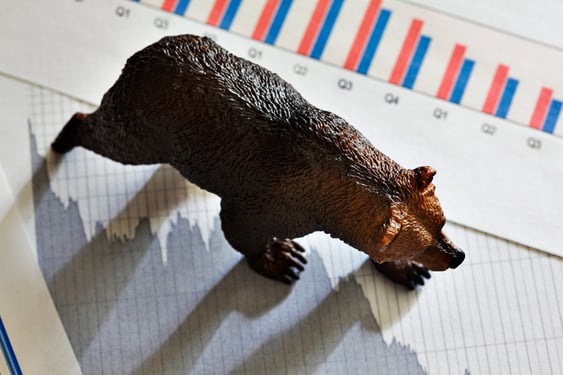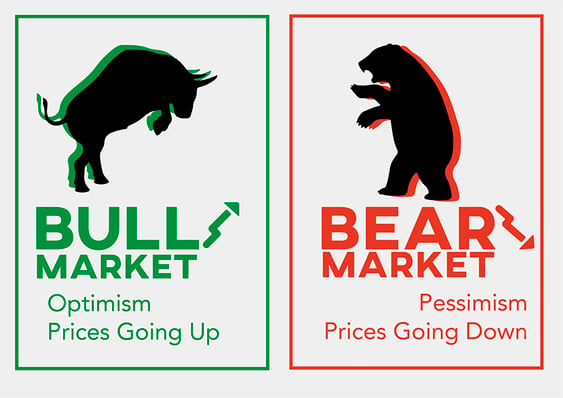2022 has been a year to remember, in more ways than one. Your employees are facing record inflation with the national average hitting highs we haven’t seen since 1983. We are not in a recession yet, but there are many economists who fear that we are trending in that direction. In response, the Bank of Canada continues to raise interest rates as they attempt to keep inflation from completely spiralling out of control and to top it all off, the markets have been trending downward since January. Read on to learn what a bear market is and the measures you can take as an employee or an employer to get through these trying times with confidence.

What does it mean to be entering a bear market?
A bear market is when a market experiences significant price declines over 20% occuring in a short period of time. Bear markets often travel in the company of economic recessions, and decrease consumer confidence. With the rapid increase of inflation and global uncertainty, experts predict that a recession will soon be on the horizon, and advise both employers and employees to take the appropriate measures to prepare for these trying times.
Although this means that savings rates on term deposits and savings accounts will see a bump moving forward, it also means that it will cost more money to borrow as rates on mortgages and lines of credit also increase. To add another layer to the current dynamic, there are still geo-political concerns as the Russia invasion of Ukraine continues to have an impact on the global supply chain. To say that these are unsettling times is an understatement.

Similar to losses we encountered in spring of 2020, when stock markets around the globe plummeted at the outbreak of COVID-19, we are finding ourselves in a volatile situation. However, those declines were short lived. There’s a good chance you’ve already forgotten about those losses, given what’s happened in the almost two years that followed. Not only did stock markets rebound and recover those initial 2020 losses, they have since moved on to set record highs throughout 2021. But all that seems to have changed after the markets hit their peak in the first week of January, and it’s been a sharp decline as 2022 unfolded. Not only are stock markets sliding, so are fixed income investments. Bonds, the usual safe haven of investors when stock markets are volatile, have also fallen into double digit negative territory. We’ve officially entered bear market territory, which is only adding to financial anxiety and concerns along with all the other economic conditions going on at this moment.
Before we give some advice to help ease the minds of your employees looking to survive, let’s first revisit what we are dealing with in the first place. This article from Morningstar does a great job of explaining the differences between a stock market correction and a bear market. A “correction” refers to a market decline greater than 10% but less than 20%. A correction tends to be short in duration and is a common occurrence with 11 ‘corrections’ taking place since the year 2000, as the article states.
When markets fall more than 20% from their previous highs, we have entered bear market territory. Bear markets tend to be longer in duration, historically lasting nine and half months on average. Some can be longer, and others have been shorter such as the one-month bear market at the onset of COVID lockdowns mentioned earlier; the shortest bear market ever.
Regardless of length, bear markets and corrections can be extremely difficult on investors’ stress levels. For companies with a younger employee demographic, this could very well be the first bear market your staff has ever encountered. We don’t know how long this current market cycle is going to continue as we head into the second half of 2022. What we do know from history is that the longer they continue, the more difficult it becomes to stay invested as negative returns compound.
We have compiled a list of expert tips to help your employees get through these challenging times. Although we must include the obligatory warning that historical performance does not guarantee future results, we can learn a lot when we revisit the bear markets of the past and have a little hindsight on our side looking forward.
How to help your employees get through these uncertain times
Don’t Panic. Sure, this is easier said than done if our thoughts begin to dwell on our eroding portfolios. But seriously, try not to overreact to what’s happening in the markets. And avoid watching your account balances rise and fall daily, doing so will only add more anxiety that could lead to making decisions based on emotion instead of your overall investment objectives(more on this later). During a bear market, some investors always seem to find a reason to sell once they lose sight of the big picture. One of the worst investor behaviours that happened in previous bear markets, and will surely happen again during this cycle, was exiting the market and selling off investments to prevent further losses. The plan is usually to wait on the sidelines for ‘things get better’ but often the result is compounding mistakes. In addition to selling off investments at a loss, they often miss the rebound and growth that comes during those first waves of recovery when they are no longer invested. Market corrections, whether they are positive or negative, are normal and very difficult to predict. We don’t know how long this negative cycle is going to continue, and we don’t know when things will turn around. Try to stay invested. No matter how tough that might seem, it’s the better plan in the long run.
Have an investment objective. Investment selection should align with your overall goals and objectives. When we are talking about long-term savings, such as retirement planning, volatility is going to be part of the journey at various points along the way. As stated earlier, there have been 11 market corrections going back to the year 2000 and there will be more along the way. Having a long-term outlook on your investments will help prevent an investor from overreacting and panicking as described above. And if you are saving for short-term periods of five years or less, you shouldn’t be investing in the stock market in the first place.
Dollar Cost average. Instead of a lump sum investment, i.e., buying everything at once, dollar cost averaging is a strategy that invests a fixed amount of money at regular intervals, regardless of what’s happening in the markets. If you have set up a company retirement or savings plan for your employees, where contributions are made at regular intervals, congratulations! You are already helping your employees incorporate this strategy through regularly occurring contributions via payroll deductions. Dollar cost averaging is one of the best tools to help somebody take the emotion out of investing. When we are focused at investing at fixed intervals it potentially helps investors avoid the temptation of timing the market or panic selling.
Diversify your investments. Diversification is important, regardless of whether we are in a bear market or not. There are specific investments, such as target date or target risk mutual funds, that make diversification decisions automatically for investors. These funds hold a blend of equity and fixed income products and are typically distributed around the globe. Even if your employees are building their own portfolios, these funds can be used as a reference to help with their allocation decisions. Some investors, who want to remain invested during bear markets, might take on more of a defensive strategy than usual. They will seek out investments that focus on dividend paying stocks or adjust the amount of exposure they have to fixed income investments. If you have a retirement plan set up for your employees, a properly designed fund menu should include a variety of fund managers, investment styles, managed and index funds, etc. to help your employees diversify their investments.
Final Thoughts
Bear markets will continue to challenge the resolve of all investors. It doesn’t matter if this is somebody’s first ever bear market or another one of many for a seasoned investor because these negative market cycles are difficult to endure. Especially when we were so used to seeing record high after record high in the markets and our investments heading into 2022. It’s important to remember that nothing lasts forever when it comes to the market cycles, good or bad. And while we do not know how long this current cycle is going to last, or if policy makers will be able to steer us clear of a recession, we know that better times eventually lie ahead. Until we get there, try not to panic and your investments will thank you in the long run.








